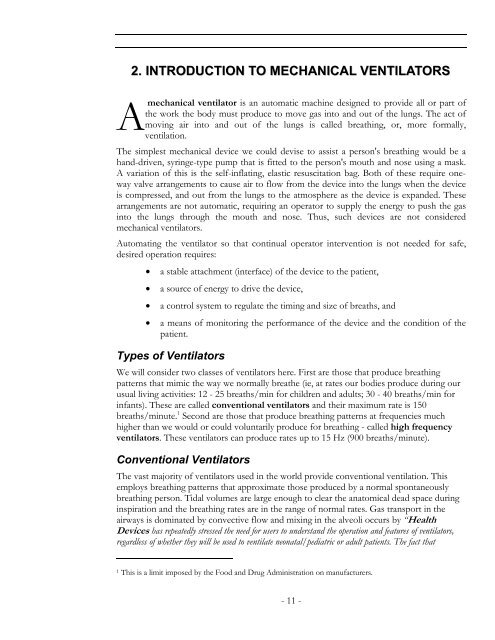Dräger Instructional CD: Mechanical Ventilation - VentWorld
Dräger Instructional CD: Mechanical Ventilation - VentWorld
Dräger Instructional CD: Mechanical Ventilation - VentWorld
Create successful ePaper yourself
Turn your PDF publications into a flip-book with our unique Google optimized e-Paper software.
2. INTRODUCTION TO MECHANICAL VENTILATORS<br />
A<br />
mechanical ventilator is an automatic machine designed to provide all or part of<br />
the work the body must produce to move gas into and out of the lungs. The act of<br />
moving air into and out of the lungs is called breathing, or, more formally,<br />
ventilation.<br />
The simplest mechanical device we could devise to assist a person's breathing would be a<br />
hand-driven, syringe-type pump that is fitted to the person's mouth and nose using a mask.<br />
A variation of this is the self-inflating, elastic resuscitation bag. Both of these require oneway<br />
valve arrangements to cause air to flow from the device into the lungs when the device<br />
is compressed, and out from the lungs to the atmosphere as the device is expanded. These<br />
arrangements are not automatic, requiring an operator to supply the energy to push the gas<br />
into the lungs through the mouth and nose. Thus, such devices are not considered<br />
mechanical ventilators.<br />
Automating the ventilator so that continual operator intervention is not needed for safe,<br />
desired operation requires:<br />
• a stable attachment (interface) of the device to the patient,<br />
• a source of energy to drive the device,<br />
• a control system to regulate the timing and size of breaths, and<br />
• a means of monitoring the performance of the device and the condition of the<br />
patient.<br />
Types of Ventilators<br />
We will consider two classes of ventilators here. First are those that produce breathing<br />
patterns that mimic the way we normally breathe (ie, at rates our bodies produce during our<br />
usual living activities: 12 - 25 breaths/min for children and adults; 30 - 40 breaths/min for<br />
infants). These are called conventional ventilators and their maximum rate is 150<br />
breaths/minute. 1 Second are those that produce breathing patterns at frequencies much<br />
higher than we would or could voluntarily produce for breathing - called high frequency<br />
ventilators. These ventilators can produce rates up to 15 Hz (900 breaths/minute).<br />
Conventional Ventilators<br />
The vast majority of ventilators used in the world provide conventional ventilation. This<br />
employs breathing patterns that approximate those produced by a normal spontaneously<br />
breathing person. Tidal volumes are large enough to clear the anatomical dead space during<br />
inspiration and the breathing rates are in the range of normal rates. Gas transport in the<br />
airways is dominated by convective flow and mixing in the alveoli occurs by “Health<br />
Devices has repeatedly stressed the need for users to understand the operation and features of ventilators,<br />
regardless of whether they will be used to ventilate neonatal/pediatric or adult patients. The fact that<br />
1 This is a limit imposed by the Food and Drug Administration on manufacturers.<br />
- 11 -


